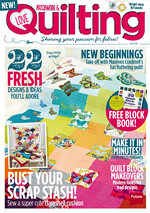You will need:
Fat eighths of at least 14 different prints (I used 28 Dear Stella Confetti Dot prints here, 2 circles from each)
1 roll of fusible web (such as Heat 'n Bond Steam a Seam Lite or Pellon Wonder Under)
2 yds background fabric
3 yds backing fabric (or pieced 50 x 58" backing)
1/2 yd binding
Small rotary cutter and 5" circle template (download here)
OR
Fabric cutting machine (such as Accuquilt Go! Baby) and 5" circle die
Cutting Instructions:
1. Cut a 7" x WOF strip from your background fabric. While still folded in half, cut 3 7x7" squares (for a total of 6). Continue until you have 56 - 7x7" squares.
2. Cut 5.5" strips from the roll of fusible web. Press interfacing to the wrong side of your fat eighths.
3a. If you are using a rotary cutter and circle template, place circle template on top of the fabric and cut around the template. You'll need 4 circles from each print if you are using 14 fabrics, or 2 circles from each print if you're using 28 fabrics.
3b. If you are using a fabric cutting machine, cut out the interfaced 5-1/2" strip from each fat eighth. Cut into 5-1/2" squares (4 squares if using 14 fabrics, 2 squares if using 28 fabrics). Use fabric cutting machine to cut out circles from the squares you just cut.
Assembly Instructions:
4. Fold background fabric squares in half and press. Unfold, and fold in the other direction and press again to find the center of each block where the lines intersect. Repeat this process on your circles (with the backing still applied to the fusible web) to find the center of each circle. Peel off the paper backing from each circle, and align the center of the circle to the center of the background fabric. Press to fuse the circle to the background fabric. Repeat for all blocks.
5. Use an applique stitch on your sewing machine to stitch the circles to the background fabric. Pull the thread tails to the back of the block and knot to secure. Repeat for all blocks.
6. Lay out your blocks in a 7 x 8 grid. Label each block to keep them in order if you aren't using a design wall (A1, A2, B1, B2, etc).
7. Piece each row of blocks together. To do this, take two adjacent blocks (A1 and A2 for example), and place them right sides together. A1 should be placed first, right side up. A2 will be placed on top of A1, right side down. Pin along the right edge of the blocks. Sew blocks together along pinned edge using a 1/4" seam allowance.
8. Open the blocks you just joined and place the next block in the row (A3 in this example) on top of the A2 block. Pin along the right edge and sew blocks together using a 1/4" seam allowance. Repeat until the entire row is joined, and then press the seams open. Repeat for each row.
9. Piece columns together. To do this, take two adjacent rows (A and B for example) and place them right sides together. A should be placed right side up, and B will be placed on top of A, right side down. Pin along the bottom edge of the blocks, making sure that the seam intersections match up by pinning those in place. Sew rows together with a 1/4" seam allowance.
10. Open the rows you just joined and place the next row of blocks (C in this example) on top of the B row. Pin along the right edge and sew rows together using a 1/4" seam allowance. Repeat until all rows are joined, and then press the seams open. You have a finished quilt top!
11. Piece together a backing that is at least 50 x 58".
12. Baste the quilt layers together. Place backing on a large flat surface, right side down. Then place quilt batting on top of the backing, making sure the layers are smooth. Place quilt top on top of the batting, right side up. Again, smooth out the layers as well as possible. Place basting pins all over the quilt top to baste the layers together. Start in the middle of the quilt and work your way out, smoothing the layers as you go. I placed my pins in the center of each circle to avoid having to move them during the quilting process.
13. Now it's time to quilt the layers together. I like to quilt a grid that follows the outlines of the blocks. Using a walking foot, and with your machine set to a straight stitch, sew a line about 1/4" from each of seam on both sides. Continue along each seam.
14. This part is optional, but you can also quilt around each circle as well. This part takes awhile!
15. Trim along the edges of the quilt to square it up.
16. Cut five 2-1/2" binding strips. Make binding and attach it to the quilt using you desired method (find my tutorial here). Handstitch binding to the back of the quilt.
17. Snuggle up with your new quilt!























.jpg)








.jpg)


.jpg)



.jpg)



.jpg)
.jpg)

.jpg)








.jpg)

 Welcome to Bijou Lovely. This blog is named after my great grandmother, Bijou Lillian, who encouraged me to embrace all the lovely things that the world has to offer. I hope to provide you with inspiration for sewing, quilting, photography, design, and daily life here at Bijou Lovely! It's truly lovely to have you here.
Welcome to Bijou Lovely. This blog is named after my great grandmother, Bijou Lillian, who encouraged me to embrace all the lovely things that the world has to offer. I hope to provide you with inspiration for sewing, quilting, photography, design, and daily life here at Bijou Lovely! It's truly lovely to have you here.













